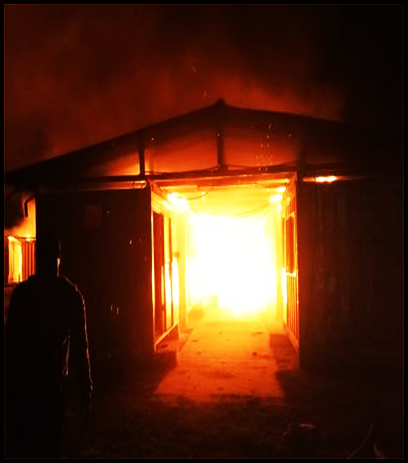-
What happened?
A fire started in a contractor’s accommodation unit.
First responders discharged fire extinguishers through a partially open window.
When they thought the fire was under control, they opened the door and the room filled with flames.
The fire spread through the roof connecting the accommodation units.
The emergency alarm and the water pumps were disabled. Respondents had to fight the fire with water buckets.
11 out of the 24 units at the camp were impacted by the fire. There were no injuries.

-
Why did it happen?
Fire started from a laptop that was plugged in for charging and left unattended on the bed.
Limited space available for charging devices due to room layout (sockets positioned just above the bed).
Shortcomings with the fire safety of the camp that allowed the fire to spread, including:
- Power was taken out from the circuit breaker by the fire, disabling the emergency siren and the water pumps.
- No firefighting system installed in the camp. Water storage tanks were at ground level, with no static head for firefighting.
- Fire emergency response plans were under-developed and untested.
- When building the camp, inspections did not identify shortcomings in fire safety.

-
What did they learn?
Portable personal equipment presents a fire risk.
Personal electrical appliances (e.g. coffee machines) should be banned from use.
Mobile phones, tablets and laptops should only be charged using the original charging equipment, which should be removed from sockets when unattended.
Ensure camp residents are made aware of the risks associated with charging personal electronic products.
Emergency response scenarios should be developed and communicated following fire safety assessments for temporary accommodation camps.
Ensure regular inspections and testing are carried out for convenience sockets in remote accommodations (i.e. residual current device test, earth loop impedance of protective conductors, insulation resistance measurements).

-
Ask yourself or your crew
How can something like this happen here? What can you do to prevent it?
What personal electronic equipment do you have? Where is it charged?
What are the fire hazards in our camp?
How do we know that our camp construction meets fire safety standards?
Are you familiar with the fire emergency plans on this site? What is your role in case a fire breaks out?
How can we improve our emergency response procedures?

Add to homescreen
Content name
Select existing category:
Content name
New collection
Edit collection
What happened?
A fire started in a contractor’s accommodation unit.
First responders discharged fire extinguishers through a partially open window.
When they thought the fire was under control, they opened the door and the room filled with flames.
The fire spread through the roof connecting the accommodation units.
The emergency alarm and the water pumps were disabled. Respondents had to fight the fire with water buckets.
11 out of the 24 units at the camp were impacted by the fire. There were no injuries.

Why did it happen?
Fire started from a laptop that was plugged in for charging and left unattended on the bed.
Limited space available for charging devices due to room layout (sockets positioned just above the bed).
Shortcomings with the fire safety of the camp that allowed the fire to spread, including:
- Power was taken out from the circuit breaker by the fire, disabling the emergency siren and the water pumps.
- No firefighting system installed in the camp. Water storage tanks were at ground level, with no static head for firefighting.
- Fire emergency response plans were under-developed and untested.
- When building the camp, inspections did not identify shortcomings in fire safety.
What did they learn?
Portable personal equipment presents a fire risk.
Personal electrical appliances (e.g. coffee machines) should be banned from use.
Mobile phones, tablets and laptops should only be charged using the original charging equipment, which should be removed from sockets when unattended.
Ensure camp residents are made aware of the risks associated with charging personal electronic products.
Emergency response scenarios should be developed and communicated following fire safety assessments for temporary accommodation camps.
Ensure regular inspections and testing are carried out for convenience sockets in remote accommodations (i.e. residual current device test, earth loop impedance of protective conductors, insulation resistance measurements).
Ask yourself or your crew
How can something like this happen here? What can you do to prevent it?
What personal electronic equipment do you have? Where is it charged?
What are the fire hazards in our camp?
How do we know that our camp construction meets fire safety standards?
Are you familiar with the fire emergency plans on this site? What is your role in case a fire breaks out?
How can we improve our emergency response procedures?
A laptop caught fire while left to charge unattended in a temporary accommodation unit. The fire spread fast, impacting 11 out of the 24 units at the camp. There were no injuries.












